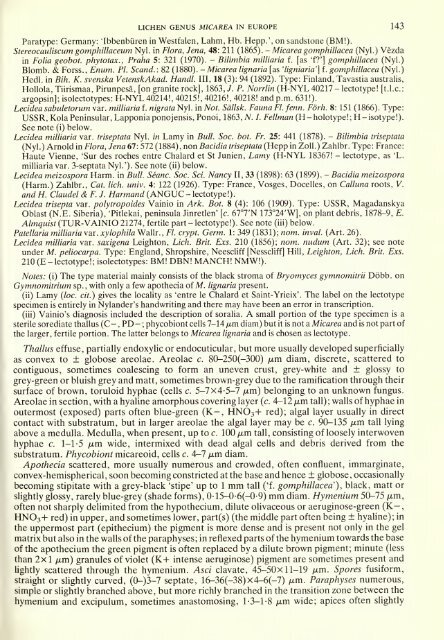Bulletin of the British Museum (Natural History)
Bulletin of the British Museum (Natural History)
Bulletin of the British Museum (Natural History)
Create successful ePaper yourself
Turn your PDF publications into a flip-book with our unique Google optimized e-Paper software.
LICHEN GENUS MICAREA IN EUROPE 143<br />
Paratype: Germany: 'Ibbenbiiren in Westfalen, Lahm, Hb. Hepp.', on sandstone (BM!).<br />
Stereocauliscum gomphillaceum Nyl. in Flora, Jena, 48: 211 (1865). - Micarea gomphillacea (Nyl.) Vezda<br />
in Folia geobot. phytotax., Praha 5: 321 (1970). - Bilimbia milliaria f. [as 'f?'] gomphillacea (Nyl.)<br />
Blomb. & Forss., Enum. PI. Scand.: 82 (1880). - Micarea lignaria [as 'ligniaria'] f. gomphillacea (Nyl.)<br />
Hedl. in Bih. K. svenska VetenskAkad. Handl. Ill, 18 (3): 94 (1892). Type: Finland, Tavastia australis,<br />
HoUola, Tiirismaa, Pirunpesa, [on granite rock], 1863,/. P. Norrlin (H-NYL 40217 -lectotype! [t.l.c:<br />
argopsin];isolectotypes: H-NYL 40214!, 402151,40216!, 40218! and p.m. 631!).<br />
Lecidea sabuletorum var. milliaria f. nigrata Nyl. in Not. Sdllsk. Fauna Fl. fenn. Forh. 8: 151 (1866). Type:<br />
USSR, Kola Peninsular, Lapponiaponojensis,Ponoi, 1863, M /. Fe/Zman (H-holotype!;H-isotype!).<br />
See note (i) below.<br />
Lecidea milliaria var. triseptata Nyl. in Lamy in Bull. Soc. bot. Fr. 25: 441 (1878). - Bilimbia triseptata<br />
(Nyl.) Arnold in Flora, Jena 67: 572 (1884), non Bacidia triseptata (Hepp in ZoU.) Zahlbr. Type: France:<br />
Haute Vienne, 'Sur des roches entre Chalard et St Junien, Lamy (H-NYL 18367! - lectotype, as 'L.<br />
milliaria var. 3-septata Nyl.'). See note (ii) below.<br />
Lecidea meizospora Harm, in Bull. Seanc. Soc. Sci. Nancy II, 33 (1898): 63 (1899). - Bacidia meizospora<br />
(Harm.) Zahlbr., Cat. lich. univ. 4: 122 (1926). Type: France, Vosges, Docelles, on Calluna roots, V.<br />
and H. Claudel & F. J. Harmand (ANGUC - lectotype!).<br />
Lecidea trisepta var. polytropoides Vainio in Ark. Bot. 8 (4): 106 (1909). Type: USSR, Magadanskya<br />
Oblast (N.E. Siberia), 'Pitlekai, peninsula Jinretlen' [c. 67°7'N 173°24'W], on plant debris, 1878-9, E.<br />
Almquist (TUR-VAINIO 21274, fertile part- lectotype!). See note (iii) below.<br />
Patellaria milliaria var. xylophila Wallr., Fl. crypt. Germ. 1: 349 (1831); nom. inval. (Art. 26).<br />
Lecidea milliaria var. saxigena Leighton, Lich. Brit. Exs. 210 (1856); nom. nudum (Art. 32); see note<br />
under M. peliocarpa. Type: England, Shropshire, Neescliff [Nesscliff] Hill, Leighton, Lich. Brit. Exs.<br />
210 (E- lectotype!; isolectotypes: BM! DBN! MANCH! NMW!).<br />
Notes: (i) The type material mainly consists <strong>of</strong> <strong>the</strong> black stroma <strong>of</strong> Bryomyces gymnomitrii Dobb. on<br />
Gymnomitrium sp. , with only a few apo<strong>the</strong>cia <strong>of</strong> M. lignaria present.<br />
(ii) Lamy (loc. cit.) gives <strong>the</strong> locality as 'entre le Chalard et Saint-Yrieix'. The label on <strong>the</strong> lectotype<br />
specimen is entirely in Nylander's handwriting and <strong>the</strong>re may have been an error in transcription.<br />
(iii) Vainio's diagnosis included <strong>the</strong> description <strong>of</strong> soralia. A small portion <strong>of</strong> <strong>the</strong> type specimen is a<br />
sterile sorediate thallus (C- , PD-<br />
phycobiont cells 7-14 /am diam) but it is not a Micarea and is not part <strong>of</strong><br />
;<br />
<strong>the</strong> larger, fertile portion. The latter belongs to Micarea lignaria and is chosen as lectotype.<br />
Thallus effuse, partially endoxylic or endocuticular, but more usually developed superficially<br />
as convex to ± globose areolae. Areolae c. 80-250(-300) /xm diam, discrete, scattered to<br />
contiguous, sometimes coalescing to form an uneven crust, grey-white and ± glossy to<br />
grey-green or bluish grey and matt, sometimes brown-grey due to <strong>the</strong> ramification through <strong>the</strong>ir<br />
surface <strong>of</strong> brown, toruloid hyphae (cells c. 5-7x4-5-7 /xm) belonging to an unknown fungus.<br />
Areolae in section, with a hyaline amorphous covering layer (c. 4—12 /xm tall); walls <strong>of</strong> hyphae in<br />
outermost (exposed) parts <strong>of</strong>ten blue-green (K-, HNO3+ red); algal layer usually in direct<br />
contact with substratum, but in larger areolae <strong>the</strong> algal layer may be c. 90-135 ixva tall lying<br />
above a medulla. Medulla, when present, up to c. 100 ^im tall, consisting <strong>of</strong> loosely interwoven<br />
hyphae c. 1-1-5 /xm wide, intermixed with dead algal cells and debris derived from <strong>the</strong><br />
substratum. Phycobiont mic2iVQO\d, cells c. A-1 /xm diam.<br />
Apo<strong>the</strong>cia scattered, more usually numerous and crowded, <strong>of</strong>ten confluent, immarginate,<br />
convex-hemispherical, soon becoming constricted at <strong>the</strong> base and hence ± globose, occasionally<br />
becoming stipitate with a grey-black 'stipe' up to 1 mm tall ('f. gomphillacea''), black, matt or<br />
slightly glossy, rarely blue-grey (shade forms), 0-15-0-6(-0-9) mm diam. Hymenium 50-75 /xm,<br />
<strong>of</strong>ten not sharply delimited from <strong>the</strong> hypo<strong>the</strong>cium, dilute olivaceous or aeruginose-green (K-<br />
HNO3-I- red) in upper, and sometimes lower, part(s) (<strong>the</strong> middle part <strong>of</strong>ten being ± hyaline); in<br />
<strong>the</strong> uppermost part (epi<strong>the</strong>cium) <strong>the</strong> pigment is more dense and is present not only in <strong>the</strong> gel<br />
matrix but also in <strong>the</strong> walls <strong>of</strong> <strong>the</strong> paraphyses; in reflexed parts <strong>of</strong> <strong>the</strong> hymenium towards <strong>the</strong> base<br />
<strong>of</strong> <strong>the</strong> apo<strong>the</strong>cium <strong>the</strong> green pigment is <strong>of</strong>ten replaced by a dilute brown pigment; minute (less<br />
than 2x1 yu,m) granules <strong>of</strong> violet (K+ intense aeruginose) pigment are sometimes present and<br />
lightly scattered through <strong>the</strong> hymenium. Asci clavate, 45-50x11-19 /xm. Spores fusiform,<br />
straight or slightly curved, (0-)3-7 septate, 16-36(-38)x4-6(-7) /xm. Paraphyses numerous,<br />
simple or slightly branched above, but more richly branched in <strong>the</strong> transition zone between <strong>the</strong><br />
hymenium and excipulum, sometimes anastomosing, 1-3-1-8 /xm wide; apices <strong>of</strong>ten slightly<br />
,

















